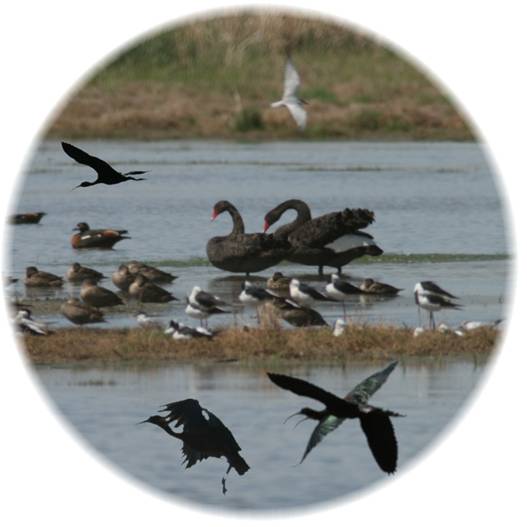Recent references to ‘Fivebough’ might cause
some subscribers to wonder just what it is. I’m not an expert on
it, but I have visited it a few times over the last 4 years. It is a
reedy depression on the outskirts of Leeton, about 2km across. On the
southern end it is adjoined by the suburbs of Leeton, on the northern by
agricultural land. It is a mixture of so-called ‘permanent
wetland’ and ‘ephemeral wetland’.
One of the things that strikes the Canberra visitor to
Griffith and Leeton is the apparently limitless amount of water that is gushing
along open channels and spilling over onto, among other things, lawns,
backyards and open and evidently non-productive spaces. Clearly, water
restrictions are unknown. The advantage of this for Fivebough is that at
this time when most ephemeral and even non-ephemeral wetlands are bone-dry
there is lots of water pouring into Fivebough, filling even spaces that I have
found to be dry at less droughty times than this. This is of great benefit
to the waterbirds that are crowding in.
When you get there, you have two ways to look at the birds,
and of course you can try both. You can take up at a vantage point at one
of the places where you can get a panoramic view, for example at the northern
lookout, where you will see this:

Actually, that makes it look a bit distant, and with
binoculars you might see something more like this. Anyway, an impressive
panorama of waterbirdlife.

The other thing you can do is walk along the constructed dry
pathways. As the Typha lining the paths is over head height, you will
only see things zipping in and out if you are quick (including snakes), until
you come to a spot where there is an open view, where you will be closer to
stuff than from a lookout, but you might find the shyer things vacating your
proximity fairly quickly. However this is your best chance of getting
close views of waders and crakes, particularly if you station yourself
noiselessly at one of those spots.
Anyway, back to my story. Last Saturday morning I was
using method 2, and finding stuff zipping off out of the corner of my eye while
I was concentrating somewhat on the presence or absence of reptiles of
the legless variety. On two occasions as I came in view of a new section
of track a raptor exploded away from the vegetation edge across the
typha-tops. On one occasion it was a Brown Goshawk carrying what appeared
to be a small rat. On the second occasion I could not identify the bird
but I think it was probably a harrier. Where it had been crouching was a
recently deceased Baillons Crake, looking something like this:

Surprisingly, although recently killed and uneaten, it was
slightly stiff as if it had been lying in the sun for an about an hour,
so maybe the raptor had been sitting there feeling good about itself and
building up an appetite.
This then is why those little crakes are often a bit on the
wary side. This story should also give heart to anyone a discouraged by
their early attempts at bird photography with their new digital camera.
Just around the corner there will be something that won’t fly away if you
take a bit of time getting the focus right.

